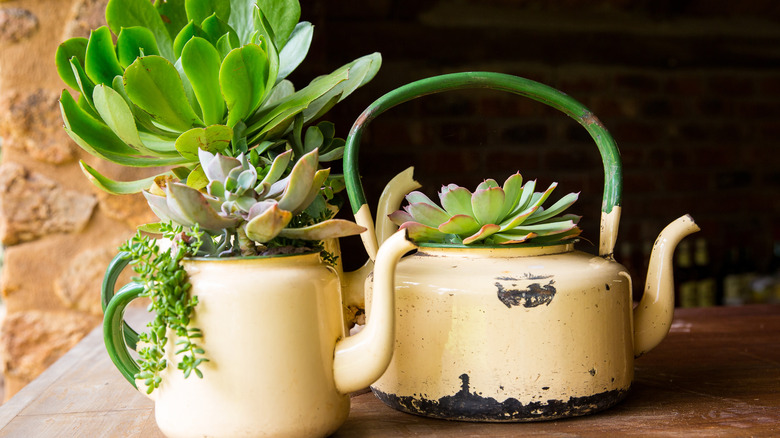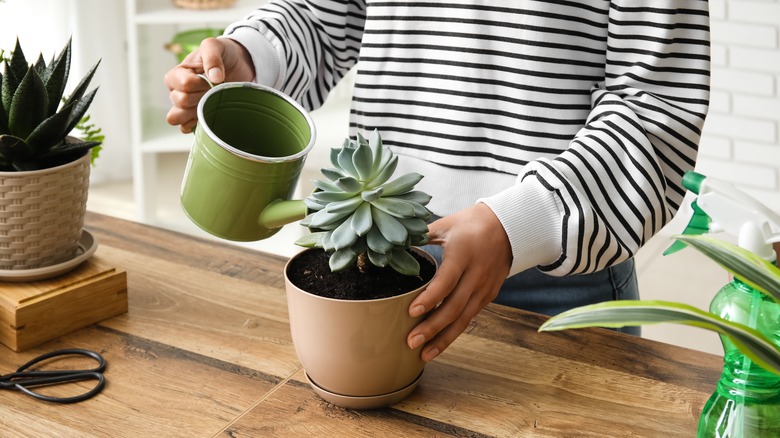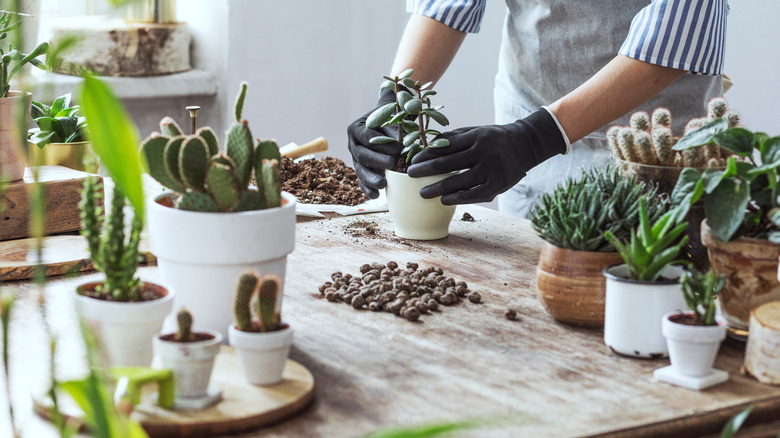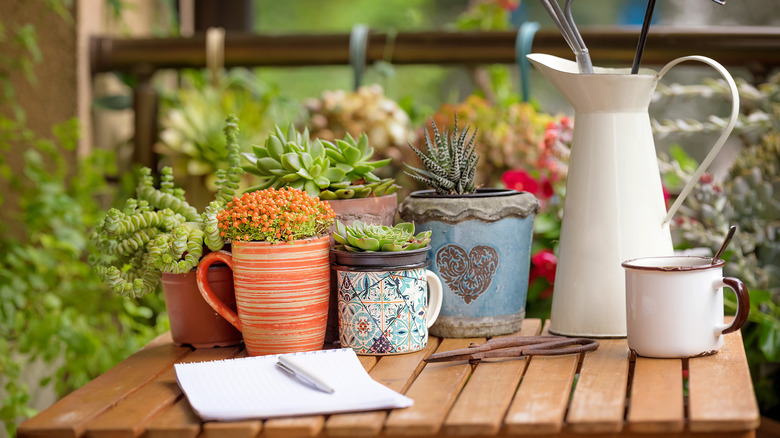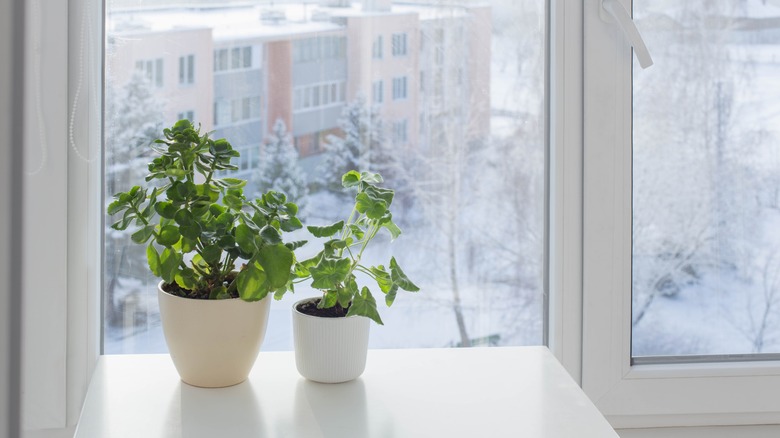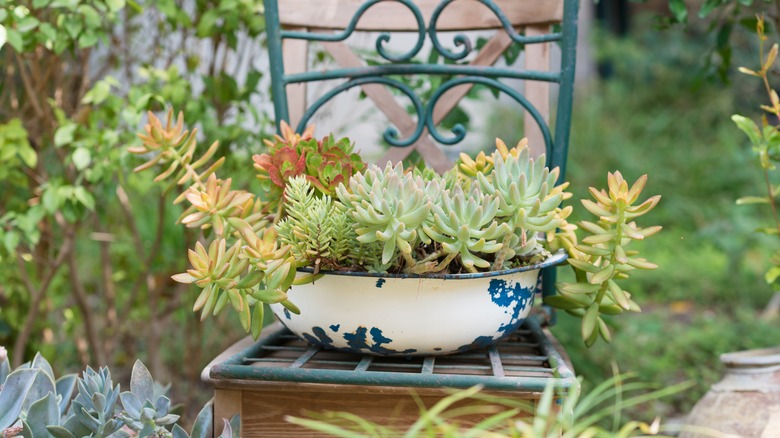How To Care For Succulents Inside And Outside Your House
Succulents are rather polarizing in the houseplant community; some people love them, and others seem never to be able to keep them alive. This is because succulents have a particular set of conditions that need to be met to see them thrive, but unlike more complicated, rare houseplants, they are incredibly low maintenance.
For those used to misting or watering your more fickle plants daily, indoors or out, succulent care may feel like a new ballgame. And, in many ways, it is. Succulents almost all come from dry, arid desert climates, notes Arizona-Sonora Desert Museum, which also explains that all cactuses are classified as succulents. There are other succulents, like aloe or agave, that aren't cacti but survive in hot and usually dry, sometimes humid, climates. As such, succulents have adapted to conserve lots of water and withstand, if not require, a certain level of neglect. The fleshy, rubbery leaves that succulents are widely sought out for actually store their water and nutrients, which is one of the most important things to know when caring for them.
Don't overwater
One of the biggest factors in succulent care is water. It can be hard to adjust to succulent watering schedules when you're used to demanding houseplants like spider plants or outdoor plants like ferns. Whether you keep your succulents indoors or planted outside, you need to ensure they don't get too much water and aren't completely forgotten about.
There is no hard and fast rule on how often to water your succulents, but a good rule of thumb is to wait until they are completely dried out to give them a drink. There are a few factors that can influence how frequently this occurs, though. Retro Den notes that outdoor succulents tend to be able to have a little more water since the heat and other elements will probably make the plant use up its water reserve faster. On the flip side, if you live anywhere besides the desert or an arid climate, keep an eye on the weather forecast and either bring your succulents indoors or shelter them outdoors if a rainstorm is on its way.
Choose the right soil
When planting and caring for succulents, you need to try and replicate their natural growing conditions as accurately as possible. If you're growing a succulent in your backyard that's native to your USDA hardiness zone, then odds are you're fine. If you're growing succulents indoors or outside anywhere cooler and wetter than the desert, you need to supplement a few factors for the plant to thrive. Proper soil is essential for succulent care. Most all-purpose soils are formulated for either tropical houseplants or garden beds and are meant to retain moisture. Succulents, though, need soil that quickly drains the water, which helps sustain their shallow roots, according to Kellogg Garden Organics. There are plenty of potting mixes specifically formulated for succulents and cactuses. Opt for a planter if your outdoor soil conditions aren't up to the plant's standards.
You can also make your own succulent soil mix, which may be more economically sound in the long run. Succulent City recommends mixing sand, garden soil, and perlite together to create a dry, well-draining, and aerated mixture that is perfect for succulents. The sand helps drain the water and dry out the soil a bit, and perlite helps aerate the soil and allow water to drain better. You can play around with this mixture to your liking, but ideally, it should be two parts, both sand and soil, and one part perlite.
Make sure they get enough light
Keeping in mind that most succulents grow in deserts or desert-like conditions, it makes sense that lots of light are another major factor for their growth and vitality. Some succulents prefer more or less light, but they generally need six to eight hours of direct sun daily, per HappySprout.
Make sure you check your specific succulent species for their light requirements. If your plant gets too little sunlight, it won't immediately die, but it will likely stop growing after some time. Most succulents won't perish from lack of sunlight, but they won't look great. On the other hand, if they get too much light for their species' needs, the leaves can burn and scorch. This isn't that big of an issue if you're growing your plants indoors or in individual pots outdoors — simply move them around as needed. If you're growing them in sizeable succulent garden tubs outdoors, ensure each plant has similar light needs.
Don't let them get too cold
While succulents aren't as sensitive to temperature fluctuations as other houseplants or outdoor plants, they aren't impervious to cold damage. Similar to light requirements, temperature preferences and limits vary from species to species. In general, though, Succulents Box says the plants prefer being kept anywhere from 60 degrees to 80 degrees Fahrenheit but can survive as low as 40 degrees Fahrenheit. A lot of people who grow indoor succulents during the colder months like to bring them outdoors in the summer when the sun and temperature requirements are high enough to sustain them, and rain isn't so prevalent. Be careful with this, though, as they may get scorched or overheated.
Consider moving them indoors, in a shaded area, or covering them with a thin cloth during summer afternoons. On the other hand, if you have outdoor succulents and live somewhere with colder falls and winters, consider bringing them indoors for the cold months. A tip to keep your succulents from being negatively affected by sudden weather changes is to avoid planting them in glass, metal, or other temperature-sensitive materials. Instead, stick to clay, terracotta, or ceramic planters, which are more insulated. Indoors, keep your succulents away from drafty windows, vents, fans, or heaters.
Fertilize your succulents
Aside from water and sun, all plants — succulents included — need nutrients to sustain their health and growth. Their nutrients are naturally replenished from the earth when planted in the ground. However, potted plants only have what comes in their potting mix, which eventually runs out. This is why plants need to be regularly repotted and fertilized. This is no different for succulents. Succulents aren't too picky about fertilizer, and according to Sublime Succulents, they'll accept almost any type of commercial houseplant fertilizer. However, they warn against mixtures with too much nitrogen, as it can encourage fungal infections or plant infestations.
There are lots of succulent and cactus-specific fertilizers available for purchase either online or at garden centers. The bottle or box should tell you how much to dilute and how to apply it. As for how often to fertilize, this varies species by species, but in general, you should only fertilize your plants in their growing seasons — early spring to late fall is a safe bet. Don't fertilize more than once or twice a season. You should also only apply fertilizer to wet soil, as it could burn the plant if applied to dry soil. If you have dissolving fertilizer sticks, simply fertilize your succulent when you water it.
